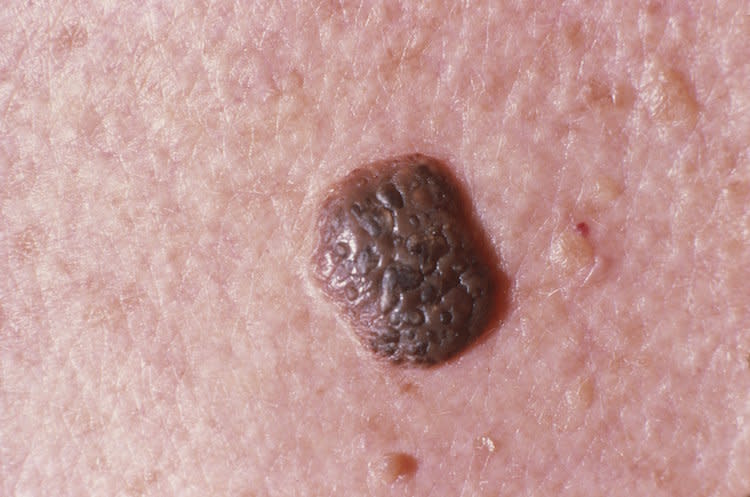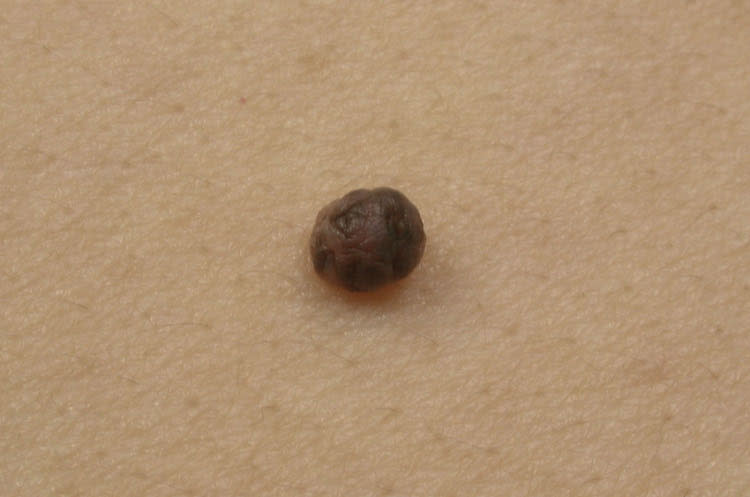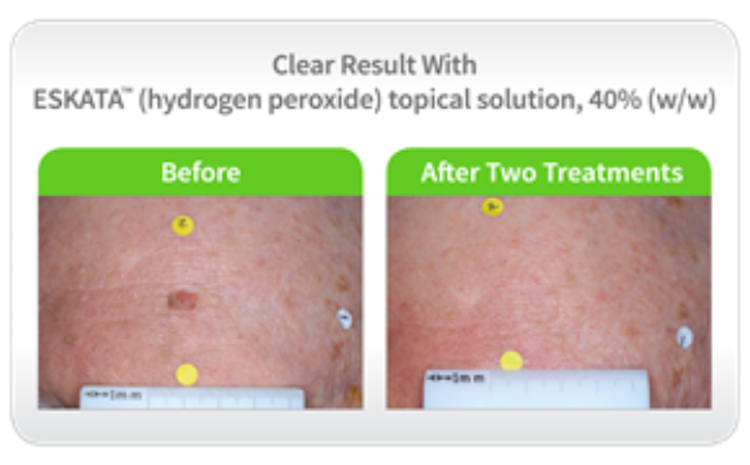What are Those Brown Spots That Aren't a Freckle But Not a Mole?
Our bodies change as we age. Some of those changes, like thinning hair and wrinkles, are no surprise. We anticipate them. Less discussed changes, however, like clusters of brown spots on your skin, are more of a surprise. Have you noticed these brown raised growths on your skin or on some of your older family members? Try not to worry — though they're not pretty to look at, they're not necessarily dangerous or a sign of bad health. It's very likely they are instances of seborrheic keratosis. But what exactly does that mean? Keep reading to learn more about this condition and what you can — and should — do about it.
What is seborrheic keratosis?
"Seborrheic keratoses are benign skin growths that are sometimes referred to as 'barnacles of life,'" says dermatologist Brendan Camp, MD, a dermatologist who sees patients in New York City and the surrounding areas. "They tend to start appearing during the fourth decade of life and they represent a growth composed of keratinocytes, or skin cells."
If you do have a seborrheic keratosis, you're definitely not alone. About 83 million Americans have one or more of these skin lesions on the face, neck, chest, shoulders or back. But seborrheic keratoses can be found anywhere on the skin, except the palms of your hands and the soles of your feet. People with dark skin are less likely to develop these growths, but they may see some smaller ones appear around their eyes.
Regardless of the location of your seborrheic keratosis, it's a good idea to make an appointment to get it examined. Though these brown skin spots are noncancerous, any unexpected skin changes should always be checked out by a dermatologist.
What does seborrheic keratosis look like?

Seborrheic keratoses "are often tan or brown in color, and as a result are sometimes mistaken as moles," says Dr. Camp. They're often round or oval in shape with slightly raised, flat surfaces and may have a rough texture not unlike that of a wart. "They can be very tiny or increase to more than an inch in diameter," says New York-based dermatologist Fayne L. Frey, MD. It’s possible to have just one of these noncancerous skin growths, but most people develop clusters of them. Don't be surprised if they don't all look alike; some growths have that warty surface, while others look like simple dabs of wax that have been pasted on the skin.

What causes seborrheic keratosis?
Doctors aren't exactly sure what causes seborrheic keratoses. However, a tendency to get them seems to be hereditary. "They are genetic so if a parent has it, you have higher likelihood of getting them," says dermatologist Shari Sperling, DO, head of Sperling Dermatology in New Jersey. These noncancerous skin growths may be linked to sun exposure. But before you cancel your beach trip, keep in mind that they are also found on skin that is usually covered, so your lifestyle may not be the best indicator of whether or not you will develop seborrheic keratosis. They're also not contagious, so you can't get them from someone or pass them on to someone else. And if seborrheic keratoses seem to grow in number and spread to other areas of your body, don't panic. Consult your dermatologist for peace of mind, but remember that you may simply be developing more of this raised skin as you get older.
What is the best treatment for seborrheic keratosis?
Because many folks get these growths when they are middle-aged or older, they are often informally known as "senile warts." Yeesh! If you don't want them on your skin, you may be wondering how to get rid of seborrheic keratosis. As unsightly as these spots are, however, if you've had them checked out by a dermatologist who confirms that they are benign and not cancer, there's nothing you need to do. "Since they are not cancerous or dangerous lesions, they do not need to be treated," confirms Dr. Frey. You may want to remove them if they become irritated or start bleeding from clothing rubbing up against them or for aesthetic reasons. Luckily, there are several methods to remove seborrheic keratoses, according to the Mayo Clinic.
Cryosurgery
This method involves freezing the seborrheic keratosis with liquid nitrogen. In this procedure, "the lesion will crust over and then fall off," according to Dr. Sperling. Though it can be effective, it's not guaranteed to work on all raised skin growths and may end up permanently lightening the treated skin. However, it is minimally invasive and fast, since it's commonly an outpatient procedure, and recovery is typically quick and painless.
Curettage
This outpatient method involves scraping the skin's surface with a special instrument. It does cause some pain and may leave behind scarring. It also isn't a permanent solution, since there's a chance for regrowth, and it may be best for removing thinner or smaller growths. Depending on where the procedure takes place, it should take about two to four weeks to heal, maybe longer when performed the lower extremities.
Electrocautery
Yet another method is electrocautery, which means burning with an electric current, and it, too, is typically an outpatient procedure. It's often used in conjunction with curettage and usually causes only mild, quick discomfort. It may help prevent regrowth, but it may not be effective on thicker growths and can leave behind scarring or discolored skin. Healing time is relatively fast, though — maybe even as fast as five to 10 days.
Ablation
There's also ablation, or vaporizing the skin growths with a laser. In this outpatient procedure, a focused light beam gets rid of the growths. This minimally invasive method has less of a chance of scarring, but it may require several treatments to remove a seborrheic keratosis. It isn't particularly painful — some patients have compared it to the sensation of a rubber band snapping against the skin. Many people fully recover form this procedure in two weeks.
ESKATA Cream
If those methods don't feel right for you, you may be interested in a less invasive option. Thankfully, the FDA approved the first topical, noninvasive treatment in 2017. "A recent consumer survey by the American Society for Dermatologic Surgery supports the need for an effective treatment of [seborrheic keratoses]," said ASDS President Lisa Donofrio, MD. "ESKATA provides physicians with the first topical treatment option to satisfy this unmet patient need." Judging by the before-and-after photos released by Aclaris Therapeutics, the results look mighty promising. It's prescription only, so ask your doctor if ESKATA might be right for you.

Remember: Always talk to a trusted doctor to find out what seborrheic keratosis treatment is right for you. Keep in mind that a treatment — no matter how effective — doesn't necessarily guarantee a seborrheic keratosis "cure." Though the skin growths are unlikely to return to the same places on your body, they may pop up elsewhere later on if you are prone to them.
Don't attempt to remove a seborrheic keratosis by yourself. As tempting as it may be to try new trends in seborrheic keratosis home removal, experts warn that there is a risk of infection. No matter how legitimate an at-home treatment may seem, this is one of those things that you — quite literally — shouldn’t take into your own hands.
This content is not a substitute for professional medical advice or diagnosis. Always consult your physician before pursuing any treatment plan.
This article originally appeared on our sister site, First for Women.

